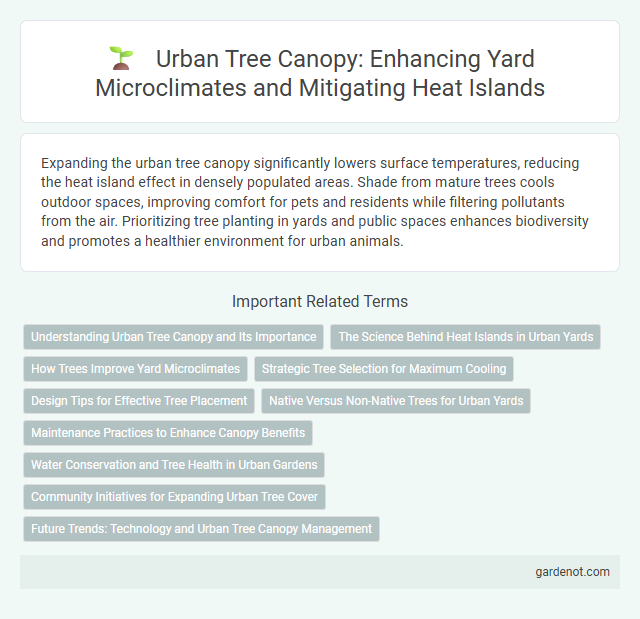Expanding the urban tree canopy significantly lowers surface temperatures, reducing the heat island effect in densely populated areas. Shade from mature trees cools outdoor spaces, improving comfort for pets and residents while filtering pollutants from the air. Prioritizing tree planting in yards and public spaces enhances biodiversity and promotes a healthier environment for urban animals.
Understanding Urban Tree Canopy and Its Importance
Urban tree canopy refers to the layer of leaves, branches, and stems of trees that cover the ground when viewed from above in urban areas. Increasing urban tree canopy directly reduces heat island effects by providing shade, cooling through evapotranspiration, and improving air quality. Strategic planning to enhance tree canopy in cities supports temperature regulation, energy savings, and overall urban resilience against climate extremes.
The Science Behind Heat Islands in Urban Yards
Urban tree canopy plays a crucial role in mitigating heat islands by providing shade and facilitating evapotranspiration, which cools the surrounding air. Research shows that tree-covered urban yards can reduce surface temperatures by up to 20degF compared to barren areas, directly impacting microclimate regulation. Scientific studies emphasize the importance of strategically planting diverse, mature trees to maximize shading and enhance heat dissipation, thereby improving overall urban thermal comfort.
How Trees Improve Yard Microclimates
Trees enhance yard microclimates by providing shade that lowers surface and air temperatures, reducing the urban heat island effect. Their transpiration process releases moisture into the air, increasing humidity and cooling the immediate environment. Dense urban tree canopies also improve air quality by filtering pollutants and reducing heat absorption from hard surfaces.
Strategic Tree Selection for Maximum Cooling
Strategic tree selection for urban heat island mitigation involves prioritizing species with high transpiration rates and dense canopies to maximize cooling effects. Trees such as oaks, maples, and elms provide substantial shade, reducing surface temperatures and lowering ambient heat in urban yards. Incorporating native, drought-resistant trees enhances sustainability while optimizing urban tree canopy coverage to combat heat stress efficiently.
Design Tips for Effective Tree Placement
Strategic tree placement maximizes urban tree canopy benefits by considering sunlight patterns, building orientation, and pedestrian pathways to enhance shade and reduce heat island effects. Designing with species diversity and appropriate spacing ensures optimal canopy coverage and air circulation while minimizing maintenance challenges. Integrating trees near impervious surfaces like parking lots and streets increases cooling impact and improves microclimate conditions in urban heat island mitigation efforts.
Native Versus Non-Native Trees for Urban Yards
Urban tree canopy plays a crucial role in mitigating heat island effects by providing shade and cooling through evapotranspiration, with native tree species often outperforming non-native varieties in climate adaptability and local ecosystem support. Native trees like oaks, maples, and birches typically require less water and maintenance, thrive in local soil conditions, and support urban biodiversity by fostering habitat for birds and insects. Selecting native species for urban yards enhances long-term sustainability and heat reduction efficiency while contributing to resilient green infrastructure.
Maintenance Practices to Enhance Canopy Benefits
Regular pruning and watering schedules improve urban tree canopy health, maximizing shade and cooling effects essential for heat island mitigation. Implementing integrated pest management and soil aeration promotes robust growth and reduces tree stress in high-temperature urban environments. Consistent monitoring and adaptive maintenance practices ensure sustained canopy density, enhancing air quality and lowering surface temperatures effectively.
Water Conservation and Tree Health in Urban Gardens
Urban tree canopies play a crucial role in heat island mitigation yards by enhancing water conservation through efficient shading and reduced soil evaporation. Integrating drought-resistant tree species and employing mulching techniques improves soil moisture retention, promoting tree health in urban gardens. Maintaining healthy urban trees supports sustained canopy cover, which effectively cools surrounding areas and reduces water demand in heat island zones.
Community Initiatives for Expanding Urban Tree Cover
Community initiatives for expanding urban tree cover play a crucial role in heat island mitigation by increasing the urban tree canopy, which lowers surface temperatures and improves air quality. Programs such as local tree planting drives, neighborhood stewardship groups, and collaboration with schools promote equitable tree distribution and enhance green infrastructure resilience. Engaging residents in tree maintenance and education leads to long-term sustainability and helps combat extreme heat impacts in densely built environments.
Future Trends: Technology and Urban Tree Canopy Management
Advanced remote sensing technologies and AI-driven analytics are revolutionizing urban tree canopy management by enabling precise mapping and monitoring of tree health and growth patterns. Innovations such as IoT-enabled sensors provide real-time data to optimize irrigation, pest control, and maintenance, enhancing tree survival in urban heat island mitigation efforts. Future trends emphasize integrating smart systems with urban forestry to maximize cooling benefits and improve ecosystem services in rapidly urbanizing environments.
Urban tree canopy Infographic

 gardenot.com
gardenot.com